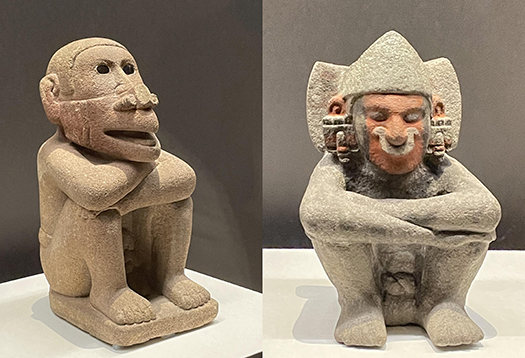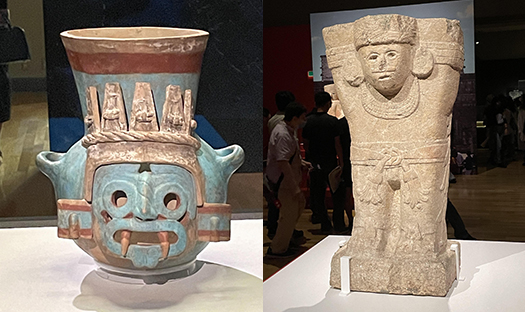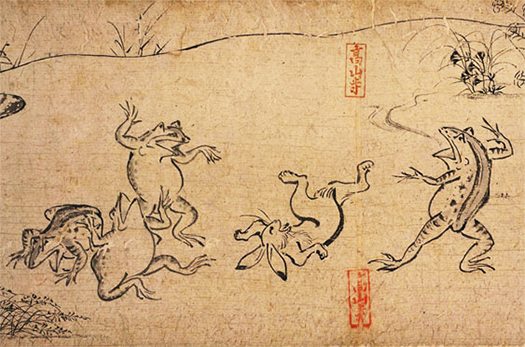

これらの写真は特別展で示されていたアステカ文明の特徴を彩る造形作品たち。
わたしは少年期、マンガ少年を志していました。友人たちと作画にふけり、才能豊かな友人ともめぐり会って大いに刺激を受けてその文化領域の無限の可能性を感じていた。しかし父は「こんなポンチ絵は絶対ダメだ」「食っていけるわけがない」と描き溜めていたわたしの作品群をボイラー焼却した(泣)。
驚くとともに情けないことに半分は「そうだよな、これで食べて行くのは相当の困難だ」とも感じて、父を恨んだりすることはまったくなかった。漫画家になるということは素直にスッパリと諦めた後、今度は新左翼運動にのめり込んでいったので、親不孝については誰にも負けなかった。あ、いまはそういうのも無縁であります、一応念のため(笑)。しかし結局、住宅写真メディアというカタチで出版の領域で生きてきたことを考えると、少年期の「素志」が知らずに強く影響したとも思えています。
そして、一出版人という立場にもなってみて日本文化を考えて見るとやはり京都・高山寺に納められている鳥獣戯画という巨大な存在が民族の巨人として迫って来てならない。

こういう絵画・造形感覚というのが日本人の民族性の根幹に深く関わっていると思えてならないのです。
中国大陸や朝鮮半島などからは類縁性を感じるこうした文化は少ないなかで、太平洋を遠く隔てた古代メキシコ・アステカ文明の造形群には強い「つながり」感を持ってしまう。
いわば「かわいい」感の共感力のようなものが迫ってくる気分なのですね。
妄想ですが、やはり3万年前に東アジア弧状列島で、残る者と旅立つ者とに別れた人類的DNAが太平洋の両端で、叫び声のようにして共鳴し合っていると思われてならないのです。
たぶん現代に至って日本文化が世界性をより強烈に獲得していくとしたら、マンガ文化が最大のものになっていくと思われる。すでにフランスをはじめとしたヨーロッパには文化浸食を成功させ、また東アジア圏でも日本マンガ文化に帰依してくれている若者たちが増加している。言語で世界有数の難解言語の日本語というハンディを持ちながら、平明な英語以上にわかりやすいビジュアル表現力がマンガにはある。
古代メキシコの造形感覚からはいわば人類的な文化ルーツ感、共通性を感じさせられる。日本の鳥獣戯画の表現が作り出している観念世界と、よく似た感受性表現が、強く迫ってくる。
こうした精神性の部分というのはなかなか解析しにくい領域でしょうが、人間コミュニケーションというプラットホームと考えると、なにか解析の手掛かりはあるのではないでしょうか?表現とか感受性の領域での各民族間での「近似性」をぜひ科学的に解明して欲しい。
English version⬇
Aztec Forms vs. Birds, Beasts, and Caricatures: Manga Culture in Ancient Mexico – 11
I feel that ancient Mexico has something in common in the area of sensitivity and expressiveness. I think there is a commonality that can be uncovered by clarifying the motives for expression. I think there is something in common in the area of sensitivity and expressive power in ancient Mexico.
These photos are of the Aztec civilization’s distinctive artwork that was shown in the special exhibition.
When I was a boy, I wanted to be a cartoonist. I indulged in drawing with my friends and met some talented friends who stimulated me greatly and made me realize the limitless possibilities of this cultural realm. However, my father boiler-burned all of my paintings, saying, “This kind of ponchi-e is absolutely useless” and “There is no way I can make a living from it.
I was surprised, and halfway through, I thought to myself, “Of course, it will be very difficult to make a living doing this,” and I did not resent my father at all. After giving up the idea of becoming a cartoonist, I became involved in the New Left Movement, so I was no less filial than anyone else. I am not involved in such things now, just in case you are wondering (laughs). (laugh) But in the end, considering that I have been living in the field of publishing in the form of residential photographic media, I believe that my “ambition” in my boyhood had a strong influence on me without my knowing it.
And when I think about Japanese culture from the standpoint of a publisher, I cannot help but be reminded of the huge presence of the caricatures of birds and animals housed at Kozan-ji Temple in Kyoto as giants of the nation.
This sense of painting and modeling is deeply rooted in the ethnicity of the Japanese people.
While there are few similar cultures from the Chinese continent or the Korean peninsula, I feel a strong sense of “connection” with the ancient Mexican Aztec civilization, which is located far across the Pacific Ocean.
It is a kind of “cute” feeling of empathy that is pressing in on me, so to speak.
It is a delusion, but I cannot help but think that the human DNA that was split up 30,000 years ago between those who remained and those who departed from the East Asian archipelago is resonating with each other like a cry at both ends of the Pacific Ocean.
Perhaps if Japanese culture is to acquire a more intense global character in the modern era, manga culture will be the biggest one. We have already seen a successful cultural erosion in France and other European countries, and an increasing number of young people in the East Asian region are taking refuge in the Japanese manga culture. Despite the disadvantage of Japanese being one of the most difficult languages in the world to understand, manga has the power of visual expression that is easier to understand than plain English.
The ancient Mexican sense of form makes us feel a sense of cultural roots and commonality, so to speak, among human beings. The expression of sensitivity, similar to that of the conceptual world created by the Japanese caricatures of birds and animals, comes to us strongly.
This area of spirituality may be difficult to analyze, but if we consider it as a platform for human communication, there may be some clues to analyze. I would like to see a scientific clarification of the “similarity” between the various ethnic groups in the areas of expression and sensitivity.
Posted on 9月 28th, 2023 by 三木 奎吾
Filed under: 日本社会・文化研究, 歴史探訪







コメントを投稿
「※誹謗中傷や、悪意のある書き込み、営利目的などのコメントを防ぐために、投稿された全てのコメントは一時的に保留されますのでご了承ください。」
You must be logged in to post a comment.